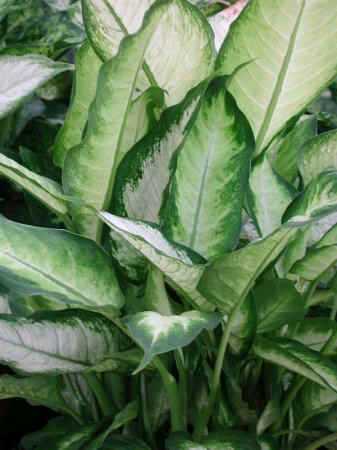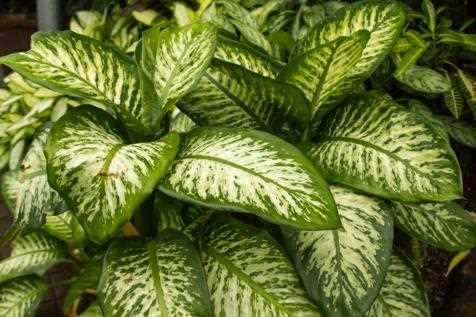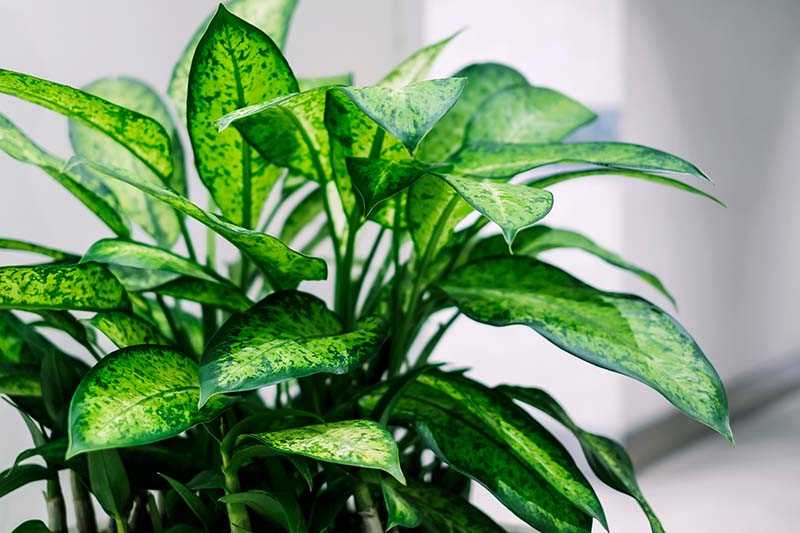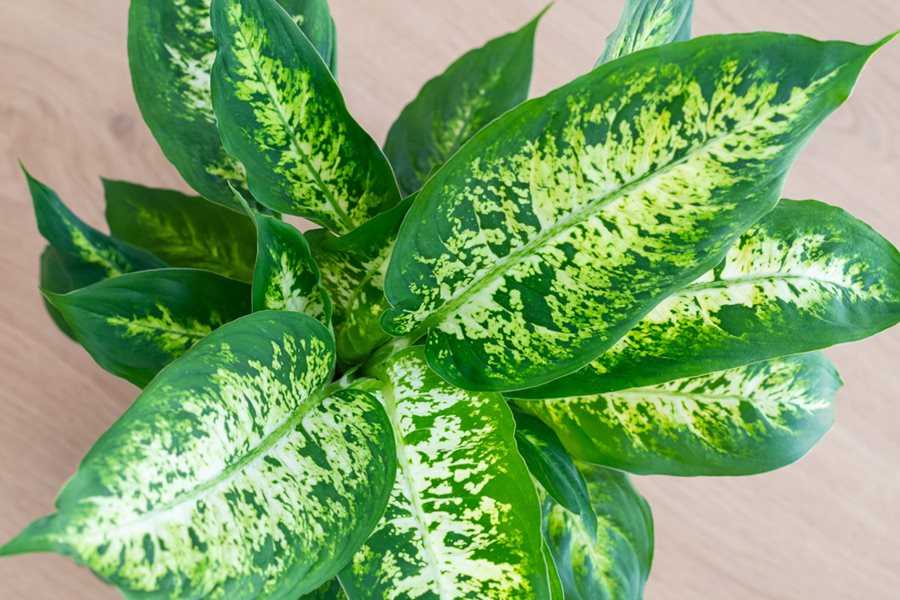- Tips for Successful Dieffenbachia Cultivation
- 1. Choose the right location
- 2. Provide the right temperature and humidity
- 3. Water properly
- 4. Fertilize regularly
- 5. Prune and clean
- 6. Propagate through stem cuttings
- 7. Watch out for pests
- 8. Rotate the plant
- 9. Be cautious of toxicity
- 10. Monitor for signs of stress
- Choosing the Right Variety
- 1. Light Requirements
- 2. Size
- 3. Leaf Patterns and Coloration
- 4. Maintenance Requirements
- 5. Toxicity
- Light and Temperature Requirements
- Light Requirements
- Temperature Requirements
- Watering and Humidity
- Watering:
- Humidity:
- Soil and Fertilization
- Tips for Fertilizing Dieffenbachia Plants:
- Fertilization Schedule for Dieffenbachia Plants:
- Pruning and Propagation Techniques
- Pruning:
- Propagation:
- Pest and Disease Prevention
- Pest Prevention:
- Common Pests:
- Disease Prevention:
- Common Diseases:
- Common Problems and Troubleshooting
- 1. Yellowing leaves
- 2. Brown spots or leaf rot
- 3. Wilting or drooping leaves
- 4. Leggy growth
- 5. Pests
- 6. Leaf drop
- Q&A:
- What are some tips for growing Dieffenbachia plants?
- How often should I water my Dieffenbachia plant?
- What is the best location for a Dieffenbachia plant?
- How can I propagate my Dieffenbachia plant?
- What temperature and humidity level does a Dieffenbachia plant require?
- Are Dieffenbachia plants toxic to pets?
- Video: Dieffenbachia rescue by propagation and some care tips!
Dieffenbachia is a popular houseplant known for its stunning foliage and easy-care nature. With its large, lush leaves and interesting variegated patterns, it adds a touch of tropical beauty to any indoor space. Dieffenbachia plants are native to the tropical rainforests of Central and South America, and they thrive in warm and humid environments.
When it comes to cultivating Dieffenbachia plants, there are several key factors to keep in mind. One important aspect is lighting. While Dieffenbachia plants prefer bright, indirect light, they can tolerate some shade. Placing them near a window with filtered light or using artificial lighting can help ensure they receive the right amount of light.
Another crucial aspect of Dieffenbachia cultivation is watering. These plants prefer consistently moist soil, but they don’t like to be overwatered. It’s important to water them when the top inch of the soil feels dry to the touch. Overwatering can lead to root rot, so it’s best to err on the side of underwatering rather than overwatering.
In addition to proper lighting and watering, Dieffenbachia plants benefit from regular fertilization. Using a balanced, water-soluble fertilizer every two to four weeks during the growing season can help provide the necessary nutrients for healthy growth. It’s important to follow the instructions on the fertilizer package and dilute it to the appropriate strength.
Overall, growing Dieffenbachia plants can be a rewarding experience. With the right care and attention to their needs, these tropical beauties can thrive indoors and bring a touch of greenery to any home or office space.
Tips for Successful Dieffenbachia Cultivation
1. Choose the right location
Dieffenbachia plants thrive in bright, indirect light. Place them near a window that receives filtered sunlight or provide them with artificial light if needed. However, avoid placing them in direct sunlight as it can scorch their leaves.
2. Provide the right temperature and humidity
Dieffenbachia plants prefer warm temperatures between 60-80°F (15-27°C) during the day and slightly cooler temperatures at night. They also thrive in humid conditions, so consider using a humidifier or placing a tray of water near the plant to increase the humidity levels.
3. Water properly
Water your Dieffenbachia plants thoroughly when the top inch of soil feels dry. Be careful not to overwater as it can lead to root rot. Allow the excess water to drain away and avoid letting the plant sit in standing water.
4. Fertilize regularly
Feed your Dieffenbachia plants with a balanced, water-soluble fertilizer every 2-4 weeks during the growing season. Follow the instructions on the fertilizer package for proper dosage and application.
5. Prune and clean
Regularly prune your Dieffenbachia plants to maintain their shape and remove any dead or yellowing leaves. Cleaning the leaves with a damp cloth or sponge will keep them dust-free and allow for better light absorption.
6. Propagate through stem cuttings

To propagate your Dieffenbachia plants, take stem cuttings from the parent plant and place them in water or moist soil. Keep the cuttings warm and provide them with indirect light until they develop roots.
7. Watch out for pests

Keep an eye out for common pests like spider mites, mealybugs, and scale insects that can infest Dieffenbachia plants. Treat any infestations promptly with organic or chemical pest control methods to prevent further damage.
8. Rotate the plant
To ensure even growth, rotate your Dieffenbachia plant every few weeks to expose all sides to light. This will prevent the plant from leaning towards the light source and result in a more balanced appearance.
9. Be cautious of toxicity
Dieffenbachia plants contain a sap that is toxic when ingested, so keep them away from curious pets and children. If you have pets or small children, consider placing the plant in a hanging basket or on a high shelf to prevent access.
10. Monitor for signs of stress
Keep a close eye on your Dieffenbachia plants for any signs of stress, such as wilting, yellowing leaves, or stunted growth. These can indicate problems with watering, light levels, or pests. Address any issues promptly to ensure the health and vitality of your plants.
Choosing the Right Variety

When it comes to choosing the right variety of Dieffenbachia for your garden or indoor space, there are several factors to consider. Each variety of Dieffenbachia has its own unique growth habits, leaf patterns, and coloration. Here are some tips to help you choose the right variety:
1. Light Requirements
Consider the amount of light your gardening space or indoor area receives. Dieffenbachia varieties can be classified as low-light, medium-light, or high-light plants. If you have a well-lit area, you can choose from a wider range of varieties. If your space is low-light, opt for varieties that are more suited for shade or indirect light conditions.
2. Size
Different Dieffenbachia varieties have different growth habits and sizes. Some varieties are more compact and bushy, while others can grow quite tall. Consider the available space in your garden or indoor area when choosing a variety. If you have limited space, opt for a compact variety or choose a larger variety if you have room for it.
3. Leaf Patterns and Coloration
Dieffenbachia plants are known for their striking leaf patterns and coloration. Some varieties have large, oval-shaped leaves with bold variegation, while others have smaller, lance-shaped leaves with unique patterns. Take into account your personal preferences and the overall aesthetic of your garden or indoor space when selecting a variety.
4. Maintenance Requirements
Consider the level of maintenance you are willing to put into caring for your Dieffenbachia plants. Some varieties require more frequent watering and higher humidity levels, while others are more tolerant of drought and lower humidity. If you don’t have a lot of time or expertise in plant care, opt for varieties that are more low-maintenance.
5. Toxicity
Dieffenbachia plants contain a toxic sap that can cause skin irritation and other symptoms if ingested. If you have pets or small children, it’s important to choose a variety that is less toxic or take precautionary measures to keep them out of reach. Some varieties have lower levels of toxicity than others.
By considering these factors, you can choose the right variety of Dieffenbachia that will thrive in your garden or indoor space and meet your personal preferences and needs.
Light and Temperature Requirements
Dieffenbachia plants thrive in bright, indirect light. They prefer a location near a window with filtered sunlight. Direct sunlight can scorch the leaves, so it’s important to provide some shade or use curtains to diffuse the light.
Temperature is another important factor for Dieffenbachia plants. They prefer a warm environment with temperatures ranging between 65-75 degrees Fahrenheit (18-24 degrees Celsius). Avoid exposing the plant to extreme cold or hot temperatures, as it can cause damage to the foliage.
Light Requirements
Dieffenbachia plants need bright, indirect light to grow and thrive. Placing the plant near a north or east-facing window is ideal. If you don’t have access to natural light, you can also use artificial grow lights, such as fluorescent or LED lights, to provide the necessary light intensity.
- Place the Dieffenbachia plant in a well-lit area that receives indirect sunlight for a few hours each day.
- Avoid placing the plant in direct sunlight, as it can burn the leaves and cause damage.
- Use curtains or blinds to filter the sunlight if the plant is too close to a window and exposed to direct sunlight.
Temperature Requirements
Dieffenbachia plants prefer a warm environment with consistent temperatures. Here are some guidelines for maintaining the right temperature for your plant:
- Keep the temperature between 65-75 degrees Fahrenheit (18-24 degrees Celsius) during the day.
- Avoid exposing the plant to temperatures below 60 degrees Fahrenheit (15 degrees Celsius), as it can cause the leaves to droop and turn yellow.
- During winter, when the temperatures may drop, protect the plant from cold drafts and keep it away from windows or doors.
- Avoid placing the plant near heating vents or radiators, which can create uneven temperature conditions.
By providing the right amount of light and maintaining a suitable temperature, you can ensure the healthy growth and development of your Dieffenbachia plants.
Watering and Humidity
Proper watering and providing the right humidity levels are important for the healthy growth of dieffenbachia plants. Here are some tips to keep in mind:
Watering:
- Water your dieffenbachia plants thoroughly, allowing the water to reach the root zone.
- Make sure the soil is evenly moist but not waterlogged. Overwatering can lead to root rot, while underwatering can cause the leaves to wilt.
- Check the moisture level of the soil by sticking your finger about an inch deep into the soil. If it feels dry, it’s time to water.
- During the growing season, water your dieffenbachia plants once every 7-10 days. Adjust the frequency based on the temperature and humidity levels.
- Avoid letting the plant sit in standing water, as this can lead to root rot. Make sure the pot has drainage holes.
Humidity:
Dieffenbachia plants thrive in high-humidity environments. Here are some methods to increase the humidity around your plants:
- Place a tray filled with water near the plant. As the water evaporates, it will increase the humidity levels.
- Mist the leaves with water using a spray bottle. This will provide temporary humidity and also help keep the leaves clean.
- Grouping your dieffenbachia plants together can create a microclimate with higher humidity.
- Using a humidifier in the room where your dieffenbachia plants are located can significantly increase the humidity level.
By maintaining proper watering and humidity levels, you can ensure your dieffenbachia plants remain healthy and vibrant.
Soil and Fertilization
Dieffenbachia plants prefer a well-draining soil that is rich in organic matter. A good potting mix for Dieffenbachia consists of equal parts of peat moss, perlite, and a well-aged compost or leaf mold. This combination provides a balance of moisture retention and drainage, preventing the soil from becoming overly saturated.
When it comes to fertilization, Dieffenbachia plants benefit from regular feeding during the growing season. A balanced, water-soluble fertilizer with an N-P-K ratio of 20-20-20 or 10-10-10 is suitable for Dieffenbachia plants. Dilute the fertilizer to half the recommended strength and apply it every two weeks from spring to fall. Be sure to follow the manufacturer’s instructions for proper application rates.
It’s also essential to avoid over-fertilizing Dieffenbachia plants, as excessive fertilizer can burn the roots and cause damage. Always err on the side of caution and provide nutrients sparingly rather than in excess.
Tips for Fertilizing Dieffenbachia Plants:
- Use a balanced water-soluble fertilizer with an N-P-K ratio of 20-20-20 or 10-10-10.
- Dilute the fertilizer to half the recommended strength.
- Apply the fertilizer every two weeks during the growing season.
- Follow the manufacturer’s instructions for proper application rates.
- Avoid over-fertilizing to prevent root burn and damage.
Fertilization Schedule for Dieffenbachia Plants:
Below is a suggested fertilization schedule for Dieffenbachia plants:
| Month | Fertilization Frequency |
|---|---|
| March | Early spring feeding |
| April | Regular fertilization every two weeks |
| May | Regular fertilization every two weeks |
| June | Regular fertilization every two weeks |
| July | Regular fertilization every two weeks |
| August | Regular fertilization every two weeks |
| September | Regular fertilization every two weeks |
| October | Regular fertilization every two weeks |
| November | Regular fertilization every two weeks |
| December | Reduced fertilization frequency to once a month |
| January | Reduced fertilization frequency to once a month |
| February | Reduced fertilization frequency to once a month |
Adjust the fertilization schedule based on the specific needs and growth rate of your Dieffenbachia plant. Monitor the plant for signs of nutrient deficiencies or excesses and adjust the timing and frequency of fertilization accordingly.
Pruning and Propagation Techniques
Proper pruning and propagation techniques are essential for maintaining and expanding a healthy population of Dieffenbachia plants. Here are some tips and guidelines to follow:
Pruning:
- Timing: Prune Dieffenbachia plants in the spring or early summer when they are actively growing.
- Tools: Use clean and sharp pruning shears or a knife to make clean cuts and prevent the spread of diseases.
- Remove dead or yellowing leaves: Regularly inspect your Dieffenbachia plant and remove any dead or yellowing leaves to promote healthy growth.
- Trimming overgrown stems: If your Dieffenbachia plant becomes too tall or leggy, you can trim the stems back to encourage compact and bushy growth.
- Shape and balance: Prune the plant to maintain a desired shape and to ensure balanced growth. Remove any excessive growth or branches that are overcrowding the plant.
Propagation:
- Stem cuttings: Dieffenbachia can be easily propagated through stem cuttings. Take a 4-6 inch cutting from a healthy plant, remove the lower leaves, and plant the cutting in a well-draining potting mix.
- Air layering: Another propagation method for Dieffenbachia is air layering. Make a small cut in the stem, wrap it with moist sphagnum moss or rooting hormone, and cover it with plastic wrap. Once roots develop, cut the stem below the new roots and plant it in a separate pot.
- Division: Over time, a mature Dieffenbachia plant may produce multiple stems. Carefully divide the plant by separating the stems and their roots, and replant each division in a separate pot.
Remember to provide proper care and conditions after pruning or propagating your Dieffenbachia plants. This includes providing adequate water, light, and humidity, as well as protecting them from drafts and extreme temperatures. With the right techniques, your Dieffenbachia plants will thrive and continue to beautify your indoor space.
Pest and Disease Prevention
Proper pest and disease prevention is crucial for maintaining healthy Dieffenbachia plants. Here are some tips to help you prevent and deal with common pests and diseases:
Pest Prevention:
- Inspect your plants regularly: Check your Dieffenbachia plants regularly for any signs of pests. Look for insects, eggs, webs, or any unusual spots on the leaves.
- Quarantine new plants: When bringing new plants into your Dieffenbachia collection, keep them separate from your existing plants for a couple of weeks. This will help prevent the spread of any potential pests to your established plants.
- Maintain cleanliness: Keep your growing area clean by regularly removing fallen leaves, debris, and dead plant material. Pests are often attracted to decaying organic matter.
- Avoid overwatering: Overwatering can create a moist environment that promotes pest infestations. Be sure to provide your Dieffenbachia plants with proper drainage and only water them when the top inch of soil feels dry.
Common Pests:
- Spider mites: These tiny pests can cause webbing and stippling on the leaves. Treat spider mite infestations by regularly misting the foliage to increase humidity, using insecticidal soap, or introducing predatory mites.
- Mealybugs: Mealybugs appear as small, cotton-like clusters on the leaves and stems. Use a cotton swab dipped in rubbing alcohol to remove mealybugs, or use insecticidal soap or neem oil.
- Aphids: Aphids are small, soft-bodied insects that suck the sap from plants, causing curling or distorted leaves. Control aphids by spraying plants with a solution of water and dish soap or using insecticidal soap.
- Scale insects: Scale insects are tiny, oval-shaped pests that attach themselves to leaves and stems, sucking sap from the plant. Remove scale insects by gently scraping them off with your fingernail or using horticultural oil.
Disease Prevention:
- Provide good air circulation: Proper air circulation helps prevent the development of fungal diseases. Ensure that your Dieffenbachia plants are not overcrowded and that they have enough space between them.
- Avoid overwatering: Overwatering can lead to root rot and other fungal infections. Water your plants only when necessary and allow the soil to dry out slightly between waterings.
- Use sterile potting soil: Use high-quality, well-draining potting soil to prevent the spread of soil-borne diseases. Avoid reusing soil from infected plants.
Common Diseases:
- Leaf spot: Leaf spot is a fungal disease characterized by brown spots on the leaves. To prevent leaf spot, avoid overhead watering, remove infected leaves, and improve air circulation.
- Powdery mildew: Powdery mildew appears as a white, powdery coating on the leaves. Increase air circulation, avoid overhead watering, and use fungicidal sprays to control powdery mildew.
- Rhizoctonia root rot: Rhizoctonia root rot causes the roots to become dark and mushy. To prevent this disease, ensure proper drainage, avoid overwatering, and use sterile potting soil.
By following these pest and disease prevention measures, you can help ensure the health and vitality of your Dieffenbachia plants.
Common Problems and Troubleshooting

Dieffenbachia plants are generally easy to care for, but they can face some common problems. Understanding these problems and knowing how to troubleshoot them can help you maintain a healthy and thriving dieffenbachia plant.
1. Yellowing leaves
Yellowing leaves can be a sign of overwatering, underwatering, or a nutrient deficiency.
- Check the soil moisture and adjust your watering routine accordingly.
- Ensure that the plant is receiving enough light, as low light conditions can also cause yellowing leaves.
- Consider using a balanced fertilizer to provide essential nutrients.
2. Brown spots or leaf rot
Brown spots or leaf rot can indicate fungal or bacterial infections.
- Trim off affected leaves and ensure proper airflow around the plant.
- Avoid overwatering and make sure the soil is well-draining.
- Consider using a fungicide or bactericide to treat the infection.
3. Wilting or drooping leaves
Wilting or drooping leaves can indicate underwatering or root rot.
- Check the soil moisture and adjust your watering routine accordingly.
- If the soil is consistently wet, repot the plant in fresh, well-draining soil.
- Trim off any rotten or damaged roots before repotting.
4. Leggy growth
Leggy growth can occur if the plant is not receiving enough light.
- Move the plant to a brighter location with indirect sunlight.
- Trim back leggy stems to promote bushier growth.
5. Pests
Common pests that can affect dieffenbachia plants include spider mites, mealybugs, and aphids.
- Inspect the plant regularly for signs of pests, such as webbing, sticky residue, or small insects.
- Use insecticidal soap or neem oil to treat any infestations.
- Isolate the affected plant to prevent the spread of pests to other plants.
6. Leaf drop
Leaf drop can occur due to changes in environmental conditions or stress.
- Avoid sudden temperature changes or drafts that can stress the plant.
- Ensure consistent humidity levels and provide regular misting if needed.
- Monitor the plant for signs of pests or diseases that may be causing stress.
By addressing these common problems and troubleshooting them effectively, you can maintain a healthy and beautiful dieffenbachia plant in your indoor or outdoor space.
Q&A:
What are some tips for growing Dieffenbachia plants?
Some tips for growing Dieffenbachia plants include providing bright, indirect sunlight, watering regularly but not overwatering, and maintaining a consistent temperature and humidity level.
How often should I water my Dieffenbachia plant?
You should water your Dieffenbachia plant when the top inch of soil feels dry. It’s important not to overwater, as this can lead to root rot.
What is the best location for a Dieffenbachia plant?
The best location for a Dieffenbachia plant is one that receives bright, indirect sunlight. Avoid placing it in direct sunlight, as this can scorch the leaves.
How can I propagate my Dieffenbachia plant?
You can propagate a Dieffenbachia plant by taking stem cuttings and placing them in water or moist soil. Make sure to remove any lower leaves and keep the cutting in a warm, humid environment until roots develop.
What temperature and humidity level does a Dieffenbachia plant require?
A Dieffenbachia plant prefers temperatures between 65-80°F (18-27°C) and a humidity level of 50-60%. It’s important to avoid temperature extremes and fluctuations.
Are Dieffenbachia plants toxic to pets?
Yes, Dieffenbachia plants are toxic to pets. The sap of the plant contains calcium oxalate crystals, which can cause irritation and swelling if ingested. It’s important to keep pets away from these plants.
Video:
Dieffenbachia rescue by propagation and some care tips!







